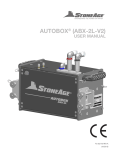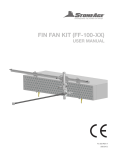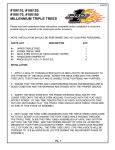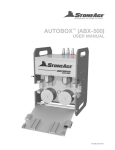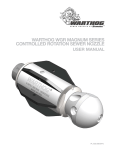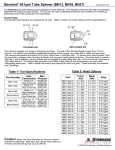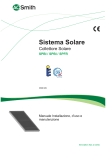Transcript
® Spitfire 15 & 22 kpsi Shotgun Swivel (SPFR-MP9-B, -MP9-S, -P8-B, -P8-S) Description: The Spitfire® is a self-rotating swivel designed for handheld shotgun waterblast cleaning. There are two inlet connection options available. The P8 tool has a 1/2 female NPT inlet port and the MP9 tool has a 9/16 medium pressure cone and thread inlet port. The P8 tool can be used at operating pressures up to 15,000 psi (1035 bar) and the M9 tool at up to 22,000 psi (1500 bar). The tools do not use any bearings, seals, or lubricating fluid. Rotation is internally self-driven, and is not dependent on orifice size. The nozzle inserts installed in the head determine the flow rate. Operation: The Spitfire® should always be used with a gun that includes a dump or pressure shut-off mechanism, so that pressure can be rapidly released. The gun barrel length including the Spitfire® should be long enough that the gun operator cannot pass the jets over his feet or legs. It is recommended that the thrust produced by the jets be no more than 1/3 the weight of the operator. Install the desired nozzle size into the head; we recommend using Parker Thread Mate and teflon tape on the nozzle threads. Attach the Spitfire® to the shotgun barrel. Flush the high pressure hose before connecting to the gun inlet. Check that the dump mechanism functions correctly before going to operating pressure. To set the operating pressure, the gun operator should close the dump on the gun, and the pump operator should slowly increase the pressure to allow the gun operator to compensate for the jet thrust. The Spitfire® head should be within 2 to 8 inches of the surface, depending on how difficult it is to remove the material. After using the Spitfire®, blow out any remaining water with compressed air and spray a light oil such as WD-40 into the tool to coat the internal surfaces. Failure to follow this procedure may cause tool not to function properly with subsequent use. Troubleshooting: Head will not rotate: Spray a light oil such as WD-40 into the tool and rotate head by hand until it turns freely again. Make sure that the jets in the head are not plugged. If the tool still does not rotate after trying this several times, it may need to be disassembled and cleaned on the inside. To do this requires a 7/16 hex socket wrench inserted onto the rear of the shaft to remove the head from the shaft. Begin by removing the Inlet Nut (SPF 002-P8 or SPF 202-MP9) from the Body (SPF 003). For the -S version, remove the Shield (SPFR 005) from the Body. For the -B version, remove the Bumper (SPFR 052) from the Head. Using a hex socket, unscrew the Shaft (SPFR 001) from the Head (SPFR 051). Make sure the two small holes in the side of the shaft are cleaned out; debris plugging these holes is the most likely cause of the tool not rotating. Inspect the stem of the Inlet Nut for galling; this can be polished slightly. ASSEMBLY NOTE: Use anti-seize lubricant on male threads of the Inlet Nut and Body. Use Loctite #242 Blue (StoneAge p/n GP 180) instead of anti-seize for the Head-to-Shaft connection. Apply 2-4 drops around the circumference of the threads on the Shaft prior to screwing it into the Head. Care must be taken not to allow excess Threadlocker into the shaft bore or onto the tapered external surface of the Shaft. Recommended minimum torque for the Inlet Nut-to-Body and the Head-to-Shaft connections is 400 in-lbs. Jetting Chart: FLOW (GALLONS PER MINUTE) PRESSURE NOZZLE DIA NOZZLE # 5000 10000 15000 20000 22000 0.020 #0.7 2.6 3.5 4.2 4.9 5.2 0.018 #0.6 2.3 3.1 3.7 4.3 4.6 SPF 202-MP9 or SPF 002-P8 Inlet Nut 0.022 #0.8 2.9 3.9 4.8 5.5 5.8 0.024 #1.0 3.3 4.4 5.4 6.2 6.6 0.026 #1.1 3.7 5 6 7 7.4 0.032 #1.7 5 6.8 8.3 9.6 10.1 AP2 XXX Nozzle (2) SPF 003 Body SPFR 001 Shaft 0.029 #1.4 4.3 5.9 7.1 8.2 8.7 0.035 #2.1 5.7 7.9 9.6 11.1 11.7 0.038 #2.5 6.5 9 11 12.7 0.042 #3.0 7.7 10.7 13 0.047 #3.8 9.2 13 0.052 #4.6 11 15.3 0.057 #5.5 12.7 RJ 008 O-Ring (2) SPF 004 Sleeve SPFR 051 Head -B (Bumper) SPFR 006 Retainer SPFR 052 Bumper GS 325-025 SHCS (2) SPFR 005 Shield Small holes in shaft -S (Sleeve) ® © 02/11/2014 StoneAge , All Rights Reserved





